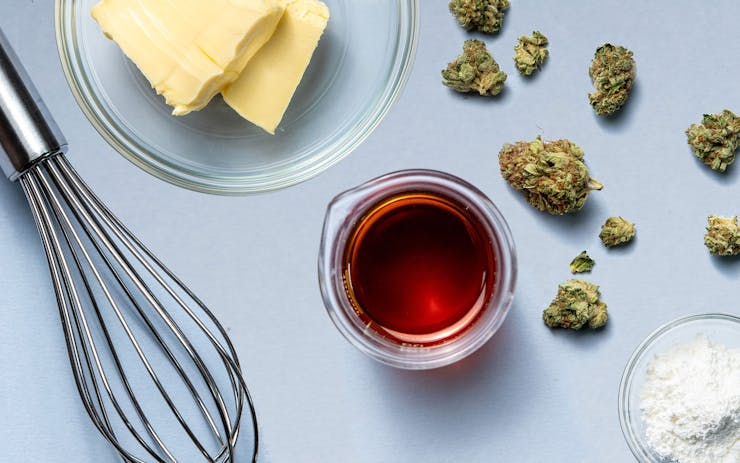There’s no shortage of cannabis recipes and cookbooks. The internet is full of ideas that’ll inspire you to dust off that mixer, roll up your sleeves and get your hands dirty making some weed-infused eats.
And whether you’re still trying to master the basics like weed butter and canna cooking oil, or have moved on to more complicated recipes that call for ingredients like homemade canna flour, there are step-by-step tutorials for every level of at-home chef.
You may notice, however, that rarely do these recipes recommend which strains to use. So, to better understand the best types of bud to use for weed-infused food, we asked Canada’s favourite cannabis chefs (all of them winners in Leafly’s Readers’ Choice Awards) to share their favourite strains to bring into the kitchen.
There are two schools of thought:
Chefs who prefer a specific strain
Chef Travis Petersen, founder of the Nomad Cook, a company that prepares cannabis-infused meals for private dinner parties and corporate events, as well as cooking classes and recipes, always considers the terpenes of the bud he uses.
“Both Sundial Lemon Riot and Top Leaf Strawberry Cream have beautiful terpene profiles for cooking,” says Chef Travis, who appeared on MasterChef Canada in 2016.
Strains that have fruity and berry-like terpenes—they are a bit easier to work with as the flavour and aroma are already pleasing and come through nicely when extracting.
John Michael MacNeil, the corporate chef at Zenabis and Namaste, also considers terpenes and how they affect the dish he’s making.
“I like fresh limonene terpenes to complement fresh-cut citrus, especially in appetizer dishes,” says Chef John. “For baking, Pink Kush is great. Its slight bitterness complements dark chocolate and cocoa. Jack Herer is fresh and also bitter, which is great for savoury applications.”
Chef Cody Lindsay of The Wellness Soldier, a platform that empowers veterans and all Canadians to learn to cook with cannabis, says he prefers working with gassy/kushy strains like OG Kush, Diesel and Purple Kush.
“Those terps come through really well when pairing with savoury applications like our gorgonzola cream sauce or chimichurri,” he says.
But everybody is different, and just like taking a hit from a Jean Guy joint might make you feel creative and happy, that same inhale could send someone else into an uncomfortable state of panic.
Chef Danny Raposo, the man behind Stoner Chef Canada, says he isn’t a fan of cooking with so-called sativas in general. (Read more on why Leafly has moved away from classifying strains as sativa or indica, focusing on terpenes and cannabinoids instead.)
“My favourite two strains to cook with are Pink Kush and Purple Kush,” says Chef Danny. “I usually only cook with indicas because that’s what works best for me and my clients.”
Missing an ingredient? Find cannabis near you.
Chefs who’ll cook with any strain
While most chefs have their favourite strains, everyone we spoke with agreed that any strain of cannabis can technically work for cooking, so as long as it’s fresh, quality flower.
“I’m quite flexible in the strains I use,” says Charlotte Langley, a cannabis chef and also the COO at Scout Canning, a Canadian seafood canning company with a focus on sustainability. “For personal consumption, I lean more heavily on the CBD strains for relaxation and stress management, but depending on the client I’m working with, the strains change based on their needs.”
Terpene engagement, she says, comes later in her process, depending on the intended outcome of the dish.
Consider this when choosing strains for cooking
Some cannabis strains are nearly fool-proof for cooking.Some strains with off-putting aromas…are a little difficult to work with their flavour profile, but can still be used in different applications.
“Strains that have fruity and berry-like terpenes—they are a bit easier to work with as the flavour and aroma are already pleasing and come through nicely when extracting,” says Chef Cody Lindsay. Think strains like Strawberry Cream, Blueberry, and Mango Haze.
And while certain strains don’t have the most appealing aromas or names, that shouldn’t deter you from experimenting either.
“Some strains with off-putting aromas such as Cat Piss, Cheese, and Sour Diesel are a little difficult to work with their flavour profile, but can still be used in different applications, like in our taco with pico de gallo and guacamole recipe,” says Chef Cody. (Note, at the time of writing, Cheese was available on the legal Canadian market. Sour Diesel and Cat Piss were not.)
Regardless of which strain you pick to cook your next meal, when it comes time to eat, always make sure to start low and go slow.





